文章目录(Table of Contents)
简介
在前面的两篇文章中,我们着重介绍了路网的生成(同时介绍了 node 和 edge 这两个文件的详情)。那么有了路网,就需要生成车流了,于是我们在这里介绍如何生成车流,同时也会介绍 route 文件的相关内容。
参考资料
生成车流(Route 文件介绍)
只有车流是不够的,还需要路网。在本次实验中,我们还是使用前面介绍的路网,使用 SUMO 进行仿真(2)-Node 和 Edge。
直接通过 rou.xml 文件
SUMO 根据 route 文件来生成车辆。因此最基础的生成车流的方式就是直接写 route 文件。这一小节会生成 rou.xml 文件。
首先定义的 vTpye 表示的是 vehicle 的类型(也就是车流最基础的就是车辆)。定义加速度,减速,长度,最大的速度,车头时距。接着我们定义 route,表示会通过的 edges。最后定义两辆车,车辆的类型和形式的路线。我们将下面的文件保存为 hello.rou.xml。
- <routes>
- <vType id="type1" accel="0.8" decel="4.5" sigma="0.5" length="5" maxSpeed="70"/>
- <route id="route0" color="1,1,0" edges="1si 3o"/>
- <vehicle id="0" type="type1" route="route0" depart="0" color="1,0,0"/>
- <vehicle id="1" type="type1" route="route0" depart="0" color="0,1,0"/>
- </routes>
- 首先我们在最上面定义车辆,使用
vType关键词进行定义。 - 接着我们定义一条路径,也就是使用
route进行定义,表示车辆从哪些边上行驶。这里需要注意的是,routes 中的 edges 一定要是相互连通的,否则会出现类似下面的报错No connection between edge '1fi' and edge '3o'. - 最后我们定义了两辆车,两辆车的类型都是 type1,都在 route0 上行驶。
在有了 route 文件之后,我们只需要新建一个 sumocfg 文件即可,需要指定 net-file 和 route-file,如下所示:
- <configuration>
- <input>
- <net-file value="../hello.net.xml"/>
- <route-files value="hello.rou.xml"/>
- </input>
- </configuration>
最后运行上面的 sumo config 文件,可以看到有两辆车在指定的路径上行驶。
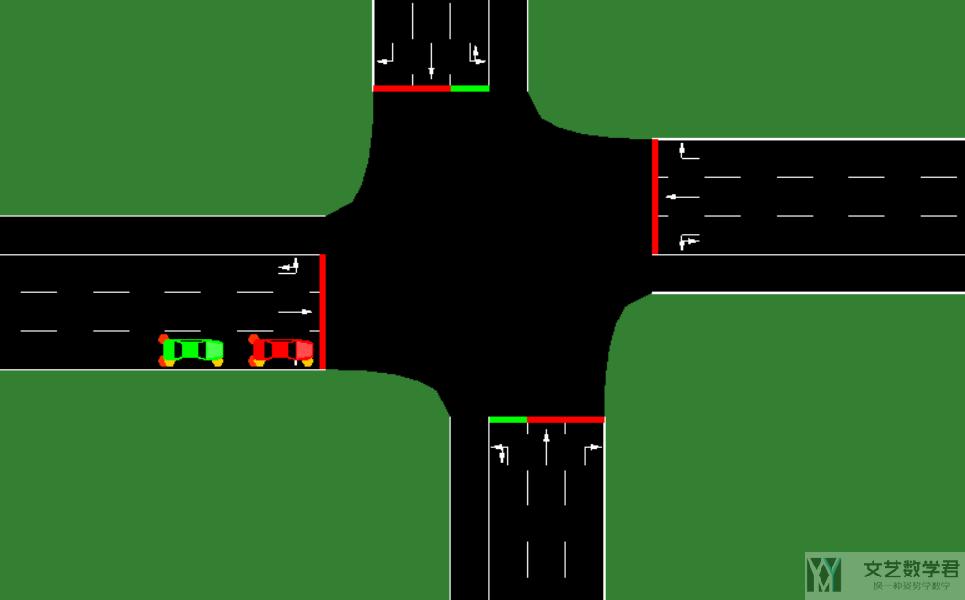
通过 trip 来定义-直接指定首末位置
上面我们介绍了直接编写 .rou.xml 文件来生成车流。但是上面的方式有一个巨大的问题,需要具体定义每一段行程(只给定起点和重点不是不可以的)。如果只给定起点和终点,可能会出现类似下面的报错,No connection between edge '1fi' and edge '3o'。
那么如果想根据给定的「起点」和「终点」生成车流,可以使用 trip 来完成。下面的实验还是基于上面的 network。关于 trip 的详细信息可以查看 SUMO--Trip Definitions。
.trip.xml 文件主要保存的内容有车辆 id (id),出发时间 (depart),始发道路 id (from) 和到达道路 id (to)。此时我们只需要定义起点和终点,中间的路程是会自动进行补全的。我们新建一个 hello.trip.xml 文件,内容如下所示(一共有 3 辆车,只给定了起点和终点,没有给中间的具体道路):
- <routes>
- <trip id="trip0" depart="0" from="1fi" to="2o"/>
- <trip id="trip1" depart="10" from="1fi" to="3o"/>
- <trip id="trip2" depart="20" from="1fi" to="4o"/>
- </routes>
接着我们将其通过 duarouter 转换为 rou.xml 的文件:
- duarouter --route-files=hello.trip.xml --net-file=../hello.net.xml --output-file=hello.rou.xml
最后的输出格式如下所示。可以看到我们在 trip 中之设置了起点 「1fi」 和终点 「2o」,这里就会自动补全中间的道路,变成「edges="1fi 1si 2o"」。
- <routes xmlns:xsi="http://www.w3.org/2001/XMLSchema-instance" xsi:noNamespaceSchemaLocation="http://sumo.dlr.de/xsd/routes_file.xsd">
- <vehicle id="trip0" depart="0.00">
- <route edges="1fi 1si 2o"/>
- </vehicle>
- <vehicle id="trip1" depart="10.00">
- <route edges="1fi 1si 3o"/>
- </vehicle>
- <vehicle id="trip2" depart="20.00">
- <route edges="1fi 1si 4o"/>
- </vehicle>
- </routes>
最后还是定义 hello.sumocfg 即可进行仿真。
- <configuration>
- <input>
- <net-file value="../hello.net.xml"/>
- <route-files value="hello.rou.xml"/>
- </input>
- </configuration>
最终仿真的结果如下所示:
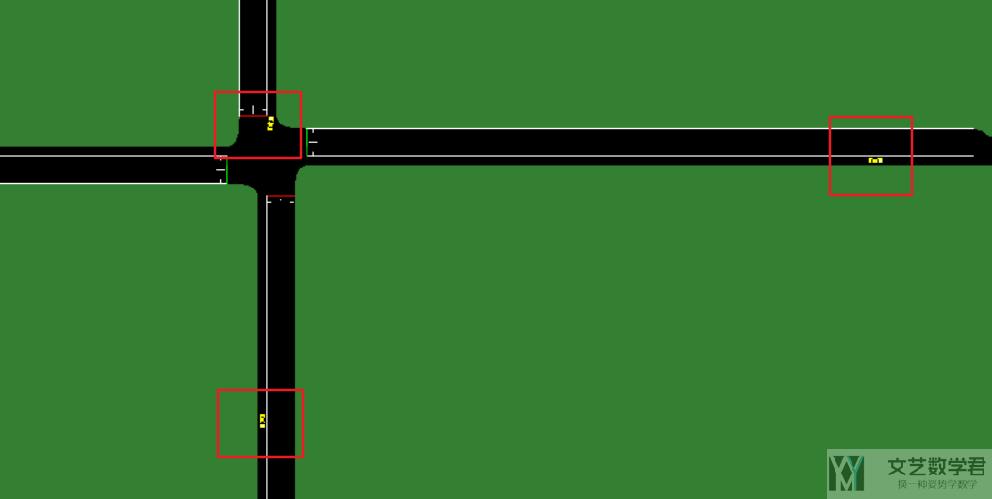
通过 flow 同时定义多个车辆(给定起点终点 duarouter)
上面我们每次设置都需要单独对每一辆车进行设置,如果车辆很多就会很麻烦。例如我们希望给定起点和终点,给定这条路线上车辆的数量,一次性生成多个车辆,前面的方法就不适用了。如果我们希望实现这样的功能,这个时候就需要使用 flow。flow 的参数如下所示(flow 是主要设置车辆数量,可以有以下的参数,vehsPerHour、period、probability、number):
- begin, first vehicle departure time;
- end, end of departure interval (if undefined, defaults to 24 hours);
- vehsPerHour, number of vehicles per hour, equally spaced (not together with period or probability);(每小时的车辆数量)
- period, insert equally spaced vehicles at that period (not together with vehsPerHour or probability);
- probability, probability for emitting a vehicle each second (not together with vehsPerHour or period), see also Simulation/Randomness;
- number, total number of vehicles, equally spaced;(给定总的车辆)
通过 flow 中的 period 和 vehsPerHour 定义连续车辆
首先我们看第一个关于 flow 的例子。我们定义了两个 flow,分别是每小时 1000 辆车,和每 5 秒会有一辆车。同时下面使用了两种不同的定义 flow 的方式(具体的如下所示):
- <routes>
- <!-- 定义两个车辆类型 -->
- <vType id="type1" accel="0.8" decel="4.5" sigma="0.5" length="5" maxSpeed="70"/>
- <vType id="type2" accel="1.2" decel="4.5" sigma="0.5" length="7" maxSpeed="120"/>
- <!-- 定义 flow, 每小时 1000 辆车 -->
- <flow id="flow1" color="1,1,0" begin="0" end= "7200" vehsPerHour="1000" type='type1'>
- <route edges="3fi 3si 4o"/>
- </flow>
- <!-- 定义 flow, 每个 5 秒有车 -->
- <flow id="flow2" color="0,1,1" begin="0" end="7200" period="5" type="type2" from="1si" to="2o"/>
- </routes>
此时的效果如下所示, 从 route(1si 2o) 有连续不断蓝色的车,route(3fi 3si 4o) 是有连续不断的黄色的车,整个过程维持 7200 秒:
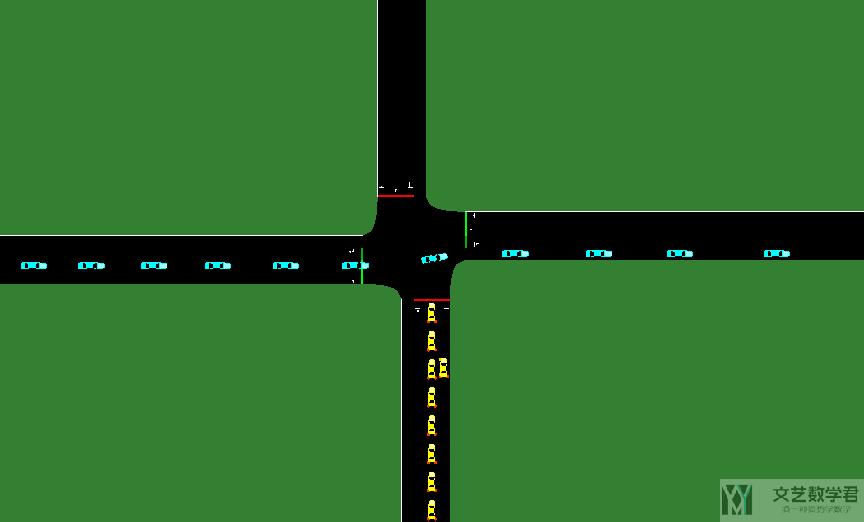
通过 flow 中的 number 生成指定数量的车辆
这个例子介绍指定车流的数量。比如我们就想要某个时间段内,某个路径上面有 100 辆车。我们新建一个 hello.trip.xml 文件,内容如下所示(包含两个时间段):
- <routes>
- <!-- 第一个时间段 -->
- <interval begin="0" end="100">
- <flow id="00" from="1si" to="2o" number="50"/>
- </interval>
- <!-- 第二个时间段 -->
- <interval begin="100" end="200">
- <flow id="10" from="1si" to="3o" number="50"/>
- <flow id="11" from="1si" to="4o" number="50"/>
- </interval>
- </routes>
flow 文件除了上面的写法之外,还可以将 begin 和 end 写在 flow 里面。
- <flow id="f2" begin="0" end="100" number="23" from="beg" to="end"/>
我们也可以指定这个 flow 经过哪些点,可以通过 via 来进行指定:
- <flow id="f2" begin="0" end="100" number="23" from="beg" to="end" via="e1 e23 e7"/>
有了上面的文件之后,接着我们将其通过 duarouter 转换为 rou.xml 的文件。
duarouter --route-files=hello.trip.xml --net-file=../hello.net.xml --output-file=hello.rou.xml --human-readable-time --randomize-flows true --departlane random --seed 30
在上面使用 duarouter 进行转换的时候,我们增加了四个参数:
- --human-readable-time,将 route 中的时间转换为
day:hour:minute:second的格式,而不是只有 second; - --randomize-flows,将车辆 depart time 随机,而不是均匀出现;
- --departlane,车辆起始的车道,我们选择 random;
- --seed,随机数种子,用来控制多次运行最终的结果是相同的;
最后生成的文件如下所示:
- <routes xmlns:xsi="http://www.w3.org/2001/XMLSchema-instance" xsi:noNamespaceSchemaLocation="http://sumo.dlr.de/xsd/routes_file.xsd">
- <vehicle id="00.0" depart="00:00:070.58" departLane="random">
- <route edges="1si 2o"/>
- </vehicle>
- <vehicle id="00.1" depart="00:00:070.91" departLane="random">
- <route edges="1si 2o"/>
- </vehicle>
- ...
- </routes>
我们运行仿真,最终的效果如下图所示:
使用 flow 定义时定义车辆类型
上面使用我们使用 flow 来定义车流,我们可以更进一步,定义不同的车辆类型。可以直接在前面加入 vType,下面我们增加了两种类型的车流,然后再 flow 的定义中增加 type 这个属性:
- <routes>
- <!-- 定义车辆类型 -->
- <vType id="type1" accel="2.6" decel="4.5" sigma="0.5" length="5" maxSpeed="70"/>
- <vType id="type2" accel="2.6" decel="4.5" sigma="0.5" length="5" maxSpeed="70"/>
- <!-- 定义车流 -->
- <flow id="221888670#10__01" begin="0" end="60" from="221888670#10" number="8" type="type1"/>
- <flow id="221888670#10__02" begin="0" end="60" from="221888670#10" number="8" type="type2"/>
- <routes>
有了这个 .trip.xml 文件,下面我们就使用 duarouter 转换为 rou.xml 的文件。
通过 TAZ(traffic assignment zone)来进行定义
上面都是指定从某一个 edge 进行出发,我们也可以指定从某些 edges 上进行出发。这里就需要用到 TAZ 的概念(This allows the departure and arrival edges to be selected from a predefined list of edges)。
我们首先定义两个 TAZ,其中 taz 就是由一些 edges 组成的,有点类似与一个小区,由一片区域组成。我们新建一个 hello.taz.xml 文件,文件内容如下所示:
- <additional>
- <taz id="TAZ_1" edges="1fi 4si"/>
- <taz id="TAZ_2" edges="2si 3si"/>
- </additional>
接着我们来生成 trip 文件。新建一个 hello.trip.xml 的文件,写入以下的内容。
- <routes>
- <interval begin="0" end="100">
- <flow id="1" depart="0" fromTaz="TAZ_1" toTaz="TAZ_2" number="50"/>
- </interval>
- </routes>
有了 hello.trip.xml 文件之后,我们使用 duarouter 来生成 hello.rou.xml 文件(有一点需要注意的,生成的 route 不会随机选择 taz 里面的 edge,而是会选择使得 travel time 最少的 edge):
- duarouter --route-files=cross.trip.xml --net-file=cross.net.xml --taz-files=cross.taz.xml --output-file=cross.rou.xml
通过 randomTrips.py 生成车流
上面是手动对车流来进行设置,我们也可以使用 randomTrips 来生成车流。最简单的使用是只需要输入network文件即可, 此时会生成一个 trips.trips.xml 文件。
- python randomTrips.py -n input_net.net.xml
关于更多的内容, 可以通过 help 命令来进行查看.
- python randomTrips.py --help
通过 Turn Probabilities 来生成车辆(jtrrouter)
上面介绍的都是给定起点和终点,给定他们之间的车辆数量从而来进行生成。但是有的时候我们希望只给定起点,和各个路口的转向比(转向概率),从而来生成车流。这个时候就可以使用Turn Definitions来首先定义每一个 edge 的转向比,接着定义 flow 和 Sinks definitions。
首先我们生成turn definition文件,这里会定义 fromEdge 到 toEdge 的概率。我们新建一个 hello.turndefs.xml 文件,写入以下的内容(主要就是定义转弯的概率):
- <edgeRelations>
- <interval begin="0" end="3600">
- <edgeRelation from="1si" to="3o" probability="0.4"/>
- <edgeRelation from="1si" to="2o" probability="0.4"/>
- <edgeRelation from="1si" to="4o" probability="0.2"/>
- </interval>
- </edgeRelations>
关于turn definition文件, 我们还可以使用 generateTurnDefs.py 来进行生成。这样会对整个 network 生成每个 edge 之间的通行概率。
- python "C:\Program Files (x86)\Eclipse\Sumo\tools\turn-defs\generateTurnDefs.py" --connections-file wj.net.xml --turn-definitions-file testflow.turndefs.xml
注意,我们使用上面生成的 turndefs 文件,在生成 route 文件的时候,可能会出现如下的报错:
- no declaration found for element 'edgeRelation'
这个只需要把生成的turn definition文件中的下面的内容去掉即可。(我也是自己尝试出来的, 去掉就可以正常运行)
- xmlns:xsi="http://www.w3.org/2001/XMLSchema-instance" xsi:noNamespaceSchemaLocation="http://sumo.dlr.de/xsd/turns_file.xsd"
接着我们生成 trip 文件。注意,这里的 trip 文件只需要 from 不需要 to。下面是一个简单的例子,将以下的内容写入 hello.trip.xml 文件中:
- <routes>
- <flow id="0" from="1si" begin="0" end="3600" number="1000"/>
- </routes>
同样的,我们可以使用randomTrips.py来生成 trip 文件,这里需要指定参数--jtrrouter,这样可以是的生成的 trip 文件只包含 from,不包含 to。
- python "randomTrips.py" --net-file=wj.net.xml --flows 3 --jtrrouter
最后,我们利用上面生成的turn definition文件和 trip 文件,生成最终的 route 文件。我们利用jtrrouter来生成 route 文件:
- jtrrouter --route-files=hello.trip.xml --turn-ratio-files=hello.turndefs.xml --net-file=../hello.net.xml --accept-all-destinations true --output-file=hello.rou.xml
注意上面需要设置参数,--accept-all-destinations true。否则可能会出现如下的报错。The route starting at edge ... could not be closed。
运行上面生成的车流,大致效果如下图(从 1si 进入,之后左转,直行和右转都是有车辆的):
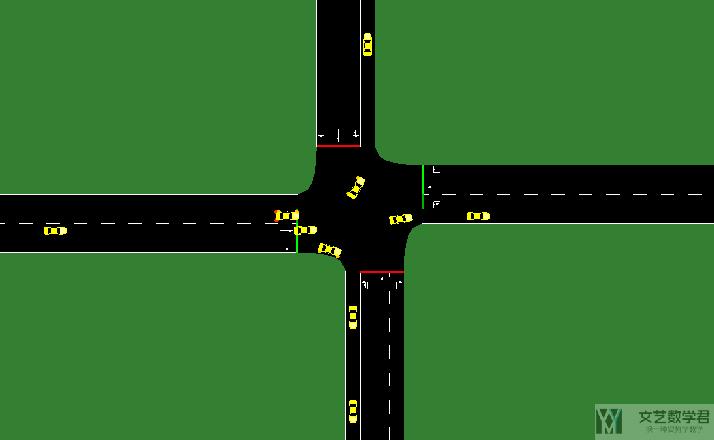
关于 jtrrouter 更多的内容,可以参考链接,jtrrouter Sumo 官方文档
- --allow-loops <BOOL>, Allow to re-use a road; default: false
- --remove-loops <BOOL> Remove loops within the route; Remove turnarounds at start and end of the route; default: false
参考资料:
- 微信公众号
- 关注微信公众号
-

- QQ群
- 我们的QQ群号
-



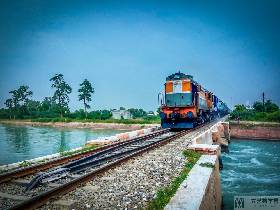





评论